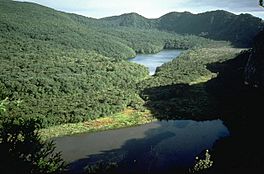Lake Aroarotamahine facts for kids
Quick facts for kids Lake AroarotamahineGreen Lake |
|
|---|---|

Caldera of the Mayor Island (New Zealand ). 1986.
|
|
| Coordinates | 37°17′0″S 176°16′2″E / 37.28333°S 176.26722°E |
| Basin countries | New Zealand |
| Surface area | 10.5 hectares (26 acres) |
Lake Aroarotamahine, also known as Green Lake, is a unique body of water in New Zealand. It is one of two small lakes located inside a volcano's crater. You can find it on Mayor Island / Tuhua, which is in the beautiful Bay of Plenty region. This lake's water flows into another smaller lake nearby, called Lake Te Paritu or Black Lake, through a wet, marshy area.
Contents
Discover Lake Aroarotamahine
Lake Aroarotamahine is a fascinating natural wonder. It's known for its distinct green color, which makes it stand out. The lake is a great example of how nature creates amazing landscapes.
Where is Green Lake?
This special lake is found on Mayor Island, also known as Tuhua. This island is actually an ancient volcano! It's located off the coast of the North Island of New Zealand. The Bay of Plenty is famous for its stunning beaches and rich Māori culture.
Why is the Lake Green?
The lake gets its name, Green Lake, from its unusual color. This green color comes from tiny living things called algae. Algae are like very small plants that grow in the water. When there are many algae, they can make the water look green. This is a natural process that happens in many lakes around the world.
A Māori Legend About the Lake
The Māori people, who are the native people of New Zealand, have a special story about Lake Aroarotamahine. This legend helps explain why the lake is green.
The story tells of a battle between two important stones. One was Pounamu, which is a precious greenstone. The other was Tuhua, which is a dark, shiny stone called obsidian. In the legend, Pounamu fought Tuhua. Pounamu was defeated in the battle. As it fled south to the South Island, its blood turned the lake green. This legend shows how important these natural elements are in Māori culture.


